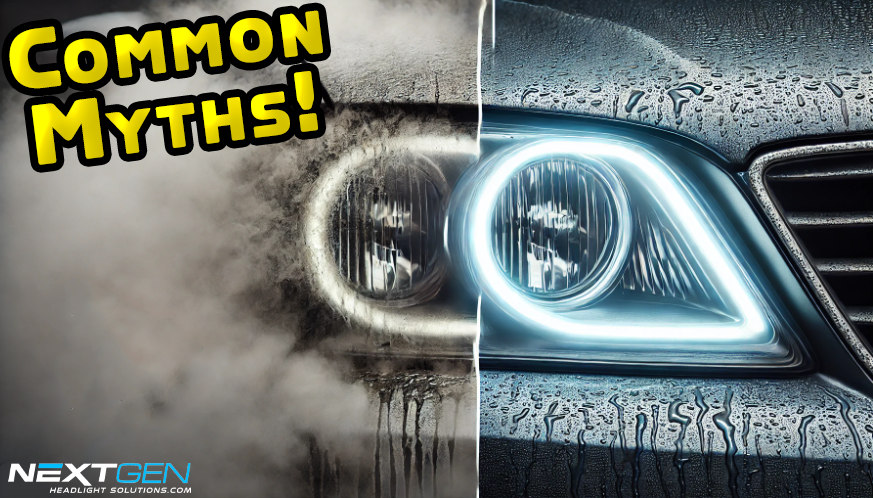Headlight restoration is a process many car owners consider when their headlights become foggy, oxidized, or yellowed. However, several myths surround headlight restoration that can lead to misconceptions and, ultimately, poor results. Let’s dive into these common myths and set the record straight on how headlight restoration really works.
Myth 1: Toothpaste Is a Permanent Solution for Headlight Restoration
Using toothpaste as a DIY headlight restoration method is a popular myth that pops up frequently. While toothpaste contains mild abrasives that can temporarily clear up the surface of your headlights, this is not a long-term solution. Toothpaste may remove some surface oxidation, but it doesn’t provide lasting protection or restore clarity to the same level as a professional-grade headlight restoration kit.
The Truth: Toothpaste can provide a quick fix, but it won’t protect against UV rays or prevent oxidation from coming back. A quality headlight restoration kit is designed with specific compounds to deliver lasting clarity and UV protection.
Myth 2: Headlight Restoration is Only for Older Vehicles
Another misconception is that headlight restoration is only necessary for older cars with severely yellowed or foggy headlights. The truth is that any vehicle, regardless of its age, can experience headlight cloudiness due to sun exposure, weather conditions, and oxidation over time. Even newer cars can benefit from regular maintenance and restoration.
The Truth: Headlight restoration can benefit both new and older vehicles. Preventative care is important to ensure your headlights remain bright and clear for as long as possible.
The Truth: Bug spray and WD-40 are not designed for headlight restoration and can do more harm than good. A proper headlight restoration kit is formulated to safely remove oxidation, improve clarity, and offer UV protection, ensuring lasting results without damaging your headlights.
Myth 3: Headlight Restoration Kits Don’t Last Long
Some believe that using a headlight restoration kit is only a temporary fix and that headlights will quickly revert to their foggy, oxidized state. This myth is often based on experiences with lower-quality products or incomplete restoration processes. High-quality restoration kits with UV-resistant coatings can provide results that last up to several years with proper maintenance.
The Truth: The longevity of restoration results depends largely on the quality of the kit used and following instructions for a complete restoration process, including the application of a UV protectant.
Myth 4: Sandpaper Will Damage Headlights
Sanding headlights might seem intimidating, and some fear it will cause scratches or damage to the lens. However, sandpaper is an essential part of many restoration processes, as it helps to not only remove oxidation effectively, but it can also remove scratches, chips and other imperfections. When done correctly, sanding can restore a smooth, clear surface without causing permanent damage.
The Truth: Using sandpaper in graduated grits is a safe way to prepare the headlight surface for polishing and coating. It’s important to follow instructions carefully to avoid over-sanding and to achieve a clean finish.
Myth 5: Headlight Restoration Doesn’t Improve Nighttime Visibility
Some believe that restoring headlights won’t make a noticeable difference in nighttime visibility, especially if their headlights are only mildly foggy. This misconception can prevent drivers from taking action, putting them at risk of poor visibility during nighttime driving.

The Truth: Clear headlights significantly improve light output, making nighttime driving safer. Even mild fogging or cloudiness can reduce the amount of light reaching the road, so regular maintenance is key to maximizing your vehicle’s lighting potential.
Myth 6: All Headlight Restoration Kits Are the Same
With so many headlight restoration kits on the market, it’s easy to assume they all provide the same results. However, the quality of these kits can vary greatly. Lower-end kits may lack key components, like a durable clear coat, and may not provide lasting results.
The Truth: Investing in a high-quality headlight restoration kit, like those offered at NextGen Headlight Solutions, ensures you get a comprehensive solution that includes the necessary abrasives, polishes, and protective coatings for a professional-grade result.
Myth 7: Professional Restoration Services Are Always Better
While professional headlight restoration services are available, they aren’t always necessary for every vehicle. With a quality DIY restoration kit, many vehicle owners can achieve results comparable to those of a professional service at a fraction of the cost.
The Truth: DIY headlight restoration kits are effective and accessible for most vehicle owners, offering a cost-efficient alternative to professional services without sacrificing quality.
Myth 8: Bug Spray and WD-40 Are Effective Headlight Restorers
It’s common to see DIY suggestions for using bug spray or WD40 to clean cloudy headlights. While these products can temporarily improve headlight clarity, they don’t actually remove the oxidation that causes cloudiness. Instead, they leave a layer of residue on the surface, which may make the headlight appear clearer for a short time but can lead to further deterioration over time. Bug spray contains chemicals that can degrade plastic, while WD-40 leaves a greasy film that attracts dirt.
Final Thoughts
Understanding the facts about headlight restoration can help you make informed decisions about maintaining your vehicle’s headlights. Don’t let myths or misconceptions keep you from enjoying clear, bright headlights. Investing in a quality restoration kit and following proper techniques can save you money, improve nighttime visibility, and prolong the life of your headlights. For the best results, explore our range of high-quality headlight restoration kits and take the first step towards a safer, clearer drive.

